The 1965 Austin-Healey 3000 Mark III BJ8, a British sports car icon, represents a pinnacle of automotive design and performance. This model, produced during the golden age of British motorsports, embodies the spirit of speed, elegance, and craftsmanship that defined the era.
Its sleek lines, powerful engine, and refined handling made it a favorite among enthusiasts, solidifying its place in automotive history.
The Mark III BJ8, a significant evolution from its predecessors, featured a larger, more powerful engine, refined suspension, and updated styling. The car’s iconic grille, distinctive headlights, and sculpted bodywork contributed to its enduring appeal. The interior, with its luxurious leather upholstery and well-designed dashboard, offered a comfortable and engaging driving experience.
The Austin-Healey 3000 Mark III BJ8: A Triumphant Finale
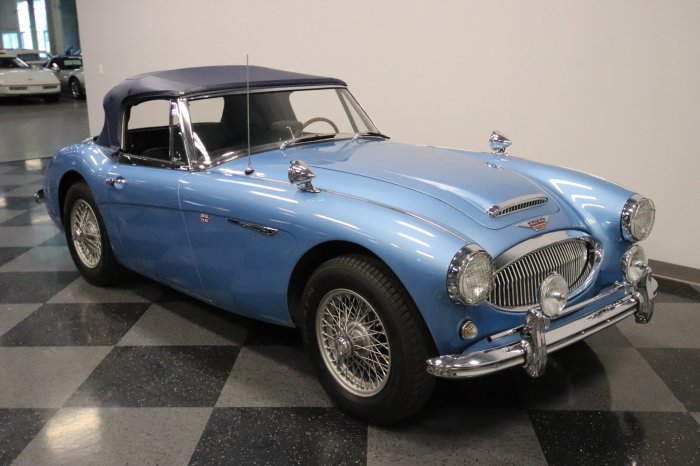
The Austin-Healey 3000 Mark III BJ8, launched in 1965, marked the culmination of a legendary sports car lineage. It was the final iteration of the 3000 series, representing the pinnacle of Austin-Healey’s design and engineering prowess. This model seamlessly blended the classic elegance of its predecessors with refined performance and contemporary styling, solidifying its place as a coveted classic among enthusiasts.
Key Features and Specifications
The 1965 Austin-Healey 3000 Mark III BJ8 embodied the spirit of its time, offering a compelling blend of style and performance. Here are some key features and specifications that define this model year:
- Engine:The BJ8 featured a 2.9-liter inline six-cylinder engine, producing 150 horsepower. This engine was known for its smooth and responsive performance, providing ample power for spirited driving.
- Transmission:The standard transmission was a four-speed manual, but a four-speed overdrive option was available. The overdrive allowed for relaxed cruising at higher speeds while maintaining fuel efficiency.
- Suspension:The BJ8 employed a sophisticated independent front suspension with coil springs and a live rear axle with leaf springs. This combination provided a comfortable ride while maintaining precise handling.
- Brakes:The car featured disc brakes on the front wheels and drum brakes on the rear. This system provided reliable stopping power, essential for a car designed for spirited driving.
- Styling:The BJ8’s styling was a refined evolution of the earlier Mark III models. It featured a more aerodynamic front end with a distinctive grille and a sloping hood. The car’s low-slung profile and sleek lines emphasized its sporty nature.
Design and Styling
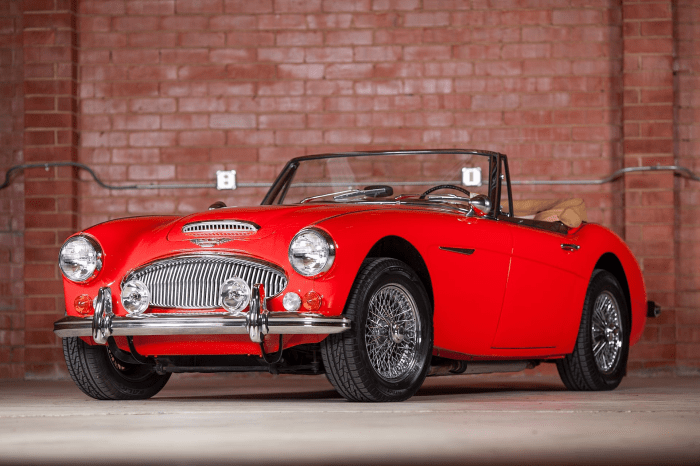
The Austin-Healey 3000 Mark III BJ8, launched in 1965, represented a subtle yet significant evolution in design, drawing inspiration from its predecessors while introducing new styling cues that cemented its place as a timeless classic. The design philosophy prioritized both performance and aesthetics, resulting in a car that was as visually captivating as it was capable on the road.The Mark III BJ8 retained the fundamental design language of the Austin-Healey 3000, characterized by its sleek, low-slung profile and distinctive roadster proportions.
However, the designers incorporated several key refinements to enhance the car’s overall appeal and aerodynamics.
Exterior Design
The front end of the Mark III BJ8 received a major update, featuring a new, wider grille with a horizontal bar design. This change not only enhanced the car’s visual presence but also improved airflow to the engine. The iconic “frog-eye” headlights, a hallmark of earlier models, were retained but given a more integrated appearance, blending seamlessly into the bodywork.
The 1965 Austin-Healey 3000 Mark III BJ8 was a stylish and powerful roadster, known for its sleek design and potent engine. While the BJ8 was a larger, more luxurious model, enthusiasts also appreciated the nimble handling and affordability of the smaller 1966 Austin-Healey Sprite.
Both models, in their own way, epitomized the spirit of British sports car engineering during that era, offering a thrilling driving experience that captured the hearts of enthusiasts worldwide.
The body lines were further refined, with smoother curves and a more sculpted profile that contributed to improved aerodynamics and a more sophisticated aesthetic.The rear end of the car also received a makeover, with the taillights being redesigned to create a more cohesive look.
The Mark III BJ8 featured a more pronounced rear deck, contributing to a sportier stance and a more streamlined silhouette.
Interior Design
The interior of the Mark III BJ8 was designed with both comfort and functionality in mind. The dashboard featured a simple, driver-focused layout with easy-to-read instruments and a well-placed gear lever. The seats were upholstered in high-quality leather, providing a combination of support and comfort.
The use of wood trim throughout the cabin added a touch of elegance and sophistication, complementing the car’s overall sporty character.The Mark III BJ8’s interior design prioritized practicality, with features such as ample storage space and a spacious trunk. The car’s open-top configuration allowed for a truly immersive driving experience, allowing occupants to enjoy the sights and sounds of the open road.
Performance and Handling
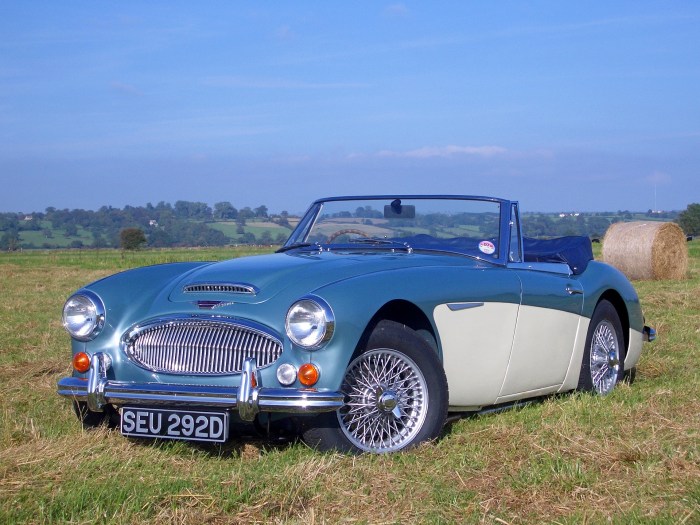
The Austin-Healey 3000 Mark III BJ8 was a triumph of engineering, offering a blend of raw power and nimble handling that made it a true sports car icon. Its performance and handling were a testament to the car’s design and the meticulous attention to detail by its creators.
Engine Specifications and Performance
The BJ8 was powered by a 2.9-liter inline six-cylinder engine, a significant upgrade from the previous Mark II model. This engine delivered an impressive 150 horsepower, a considerable leap forward for the time. The engine was mated to a four-speed manual transmission with optional overdrive, providing smooth and responsive gear changes.
The BJ8’s performance was exhilarating, with a top speed of 115 mph and a 0-60 mph time of around 9 seconds. The engine’s torque provided a satisfying surge of power, making it a joy to drive on both open roads and winding country lanes.
The 1965 Austin-Healey 3000 Mark III BJ8, the final iteration of the iconic sports car, was a testament to British engineering prowess. While the 1965 model shared many similarities with its predecessor, the 1964 Austin-Healey BJ8 , it featured refinements like a larger fuel tank and a redesigned rear suspension.
These enhancements ensured the 1965 model remained a formidable force on the road, captivating enthusiasts with its blend of performance and style.
Suspension and Braking Systems
The BJ8’s suspension system was designed to provide a balance between comfort and handling. It featured independent front suspension with coil springs and telescopic shock absorbers, while the rear suspension employed a live axle with semi-elliptic leaf springs. This configuration ensured a smooth ride and exceptional handling capabilities, allowing the car to corner with precision and stability.
The braking system consisted of disc brakes on all four wheels, providing reliable stopping power and enhanced safety.
Driving Experience
The Austin-Healey 3000 Mark III BJ8 offered a truly exhilarating driving experience. Its responsive engine, precise steering, and nimble handling made it a joy to drive on any road. The car’s low center of gravity and well-balanced chassis provided exceptional stability, allowing drivers to push the car to its limits with confidence.
The 1965 Austin-Healey 3000 Mark III BJ8 was a refined evolution of the earlier models, offering a more luxurious and refined driving experience. While it maintained the classic roadster design, the BJ8 incorporated a larger engine and a more sophisticated suspension.
The model also saw a shift in styling, with a more rounded front end and a larger grille, reflecting the design trends of the time. This shift in design was a departure from the earlier, more angular styling of the 1959 Austin-Healey 100-6 , which was a model that was more closely aligned with the classic British sports car aesthetic.
However, both models shared the same passion for driving and the thrill of open-air motoring, making them highly sought-after classics today.
The open cockpit design provided a visceral connection to the road, enhancing the overall driving experience.
Production and History
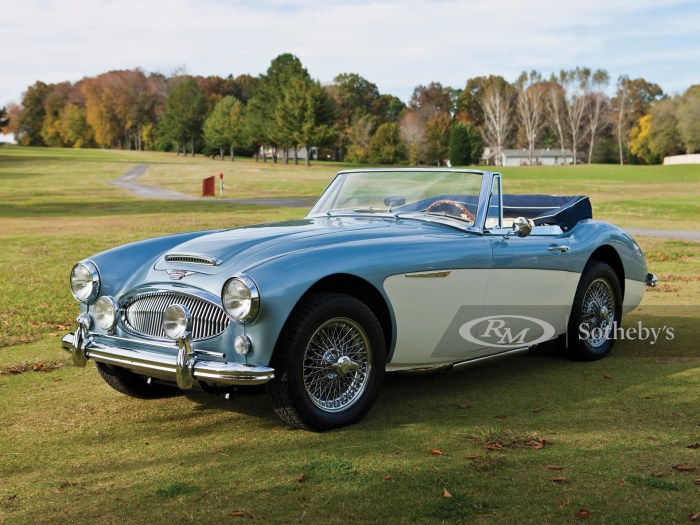
The Austin-Healey 3000 Mark III BJ8, the final iteration of the iconic sports car, was a culmination of years of development and refinement. Its production marked a significant chapter in the history of the Austin-Healey brand, leaving a lasting legacy in the world of classic automobiles.
Production Timeline and Key Milestones
The production of the Mark III BJ8 spanned from 1964 to 1967, a relatively short period compared to its predecessors. Here’s a timeline outlining key milestones:
- 1964:The Mark III BJ8 was unveiled at the London Motor Show, featuring a number of enhancements over the previous Mark II. Production began in September, with the first cars being delivered to customers shortly after.
- 1965:The BJ8 saw a surge in popularity, with production reaching its peak. Several minor changes were introduced, including the adoption of a new grille and the availability of a hardtop option.
- 1966:Production continued at a steady pace, with further refinements being made to the car’s performance and handling. The iconic “Big Healey” moniker was officially adopted, solidifying the car’s place in automotive history.
- 1967:The final year of production saw a slight decline in sales, likely due to the introduction of newer and more modern sports cars. The last BJ8 rolled off the assembly line in October, marking the end of an era for the Austin-Healey 3000.
Factors Contributing to Success and Discontinuation, 1965 Austin-Healey 3000 Mark III BJ8
The Mark III BJ8’s success can be attributed to a number of factors, including its timeless design, powerful engine, and exceptional handling. The car’s popularity was further fueled by its affordability and accessibility compared to other high-performance sports cars of the time.
- Growing Competition:The rise of more modern and technologically advanced sports cars from European and American manufacturers posed a significant challenge to the BJ8. These competitors offered better performance, fuel efficiency, and safety features, ultimately leading to a decline in sales for the aging Austin-Healey.
- Changing Market Trends:The shift in consumer preferences towards more practical and family-oriented vehicles also played a role in the BJ8’s eventual discontinuation. Sports cars like the Austin-Healey 3000 were becoming less appealing to the average buyer, who sought vehicles that could accommodate families and handle everyday driving tasks.
- Financial Challenges:The British Motor Corporation (BMC), the parent company of Austin-Healey, was facing financial difficulties in the mid-1960s. These challenges led to a decision to discontinue the Austin-Healey 3000, as the company sought to focus its resources on more profitable models.
Notable Owners and Racing Achievements
The Austin-Healey 3000 Mark III BJ8 attracted a diverse range of owners, from celebrities and racing enthusiasts to everyday drivers. The car’s performance and styling made it a popular choice for both on-road and off-road adventures.
- Steve McQueen:The iconic actor was known for his love of sports cars and owned several Austin-Healeys, including a Mark III BJ8. He famously drove a BJ8 in the film “The Thomas Crown Affair,” showcasing the car’s sleek design and exhilarating performance.
- Racing Success:The BJ8 achieved notable success in motorsport, particularly in endurance races. The car’s lightweight construction and powerful engine made it a formidable competitor, with many drivers achieving podium finishes in events like the Le Mans 24 Hours.
- Celebrity Owners:Other notable owners of the BJ8 included musician Eric Clapton, actor Peter Sellers, and British racing driver Stirling Moss. The car’s appeal transcended borders, with many American and European celebrities embracing its classic British charm.
Collecting and Restoration
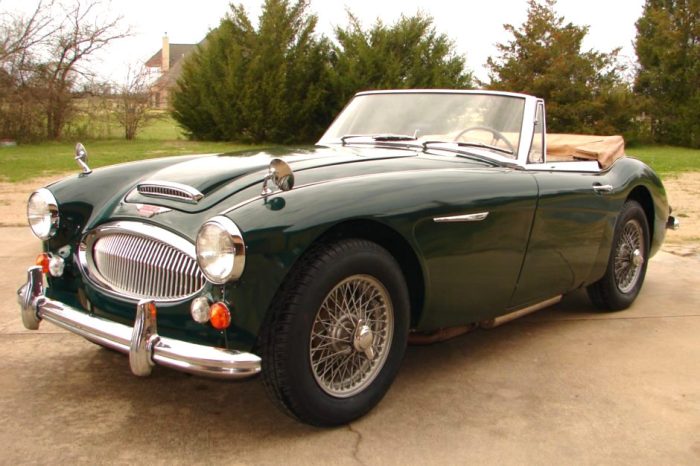
The 1965 Austin-Healey 3000 Mark III BJ8, a coveted classic car, holds a special place in the hearts of collectors and enthusiasts. Its timeless design, impressive performance, and rich history make it a highly sought-after vehicle.
The Collector Market
The collector market for the 1965 Austin-Healey 3000 Mark III BJ8 is thriving. These cars are highly collectible, and their value has been steadily increasing over the years. Factors such as condition, originality, and provenance play a significant role in determining a car’s value.
The price range for these vehicles can vary considerably. A well-maintained, original example in excellent condition can fetch upwards of $100,000, while a restored car may command even higher prices. However, less desirable cars or those in need of significant restoration can be found for lower prices, making them a more affordable entry point for collectors.
“The Austin-Healey 3000 Mark III BJ8 is a timeless classic that continues to attract collectors and enthusiasts worldwide.”
Classic Car Auction House
Restoration Challenges and Rewards
Restoring a classic Austin-Healey 3000 Mark III BJ8 is a rewarding but challenging endeavor. The process can be time-consuming and expensive, but the satisfaction of bringing a car back to its former glory is unparalleled. Restoring a classic car involves meticulous attention to detail and a deep understanding of the vehicle’s mechanics.
It requires specialized skills and knowledge, as well as access to a wide range of parts and resources.
Parts and Resources
The availability of parts for the 1965 Austin-Healey 3000 Mark III BJ8 is generally good, although some parts may be difficult to find. Many specialist suppliers cater specifically to classic car enthusiasts, offering a wide range of parts, from engine components to body panels.
Online forums and communities are valuable resources for collectors and restorers. These platforms provide a space for sharing information, advice, and parts leads. In addition to parts suppliers, there are numerous restoration shops and specialists who can assist with the restoration process.
These professionals can provide expert advice, perform complex repairs, and ensure that the car is restored to the highest standards.
Cultural Impact: 1965 Austin-Healey 3000 Mark III BJ8
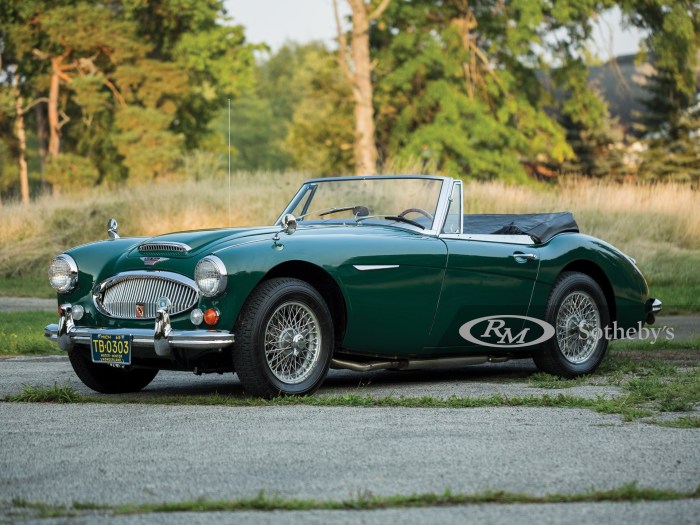
The Austin-Healey 3000 Mark III BJ8 transcended its status as a mere automobile, becoming a cultural icon that resonated across various spheres of influence. Its sleek design, potent performance, and association with a certain lifestyle cemented its place in movies, music, and popular culture, leaving an enduring legacy that continues to inspire enthusiasts today.
Association with Lifestyle and Social Groups
The Austin-Healey 3000 Mark III BJ8 was more than just a car; it was a symbol of a particular lifestyle. Its open-top design and sporty handling appealed to individuals who valued freedom, adventure, and a sense of liberation. The car was often seen cruising along coastal highways, attending car rallies, or simply enjoying a leisurely drive through picturesque countryside.
Its association with a carefree, adventurous spirit made it a popular choice among young, affluent individuals who embraced the burgeoning counterculture movement of the 1960s. The car became a symbol of a generation that sought to break free from societal norms and embrace a more individualistic approach to life.
Last Point
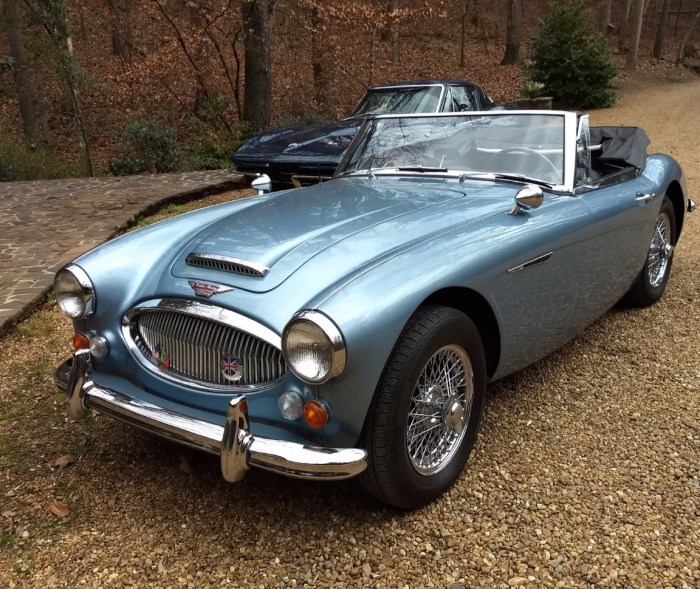
The 1965 Austin-Healey 3000 Mark III BJ8 remains a cherished classic, its legacy extending far beyond its production years. Collectors and enthusiasts continue to be drawn to its timeless design, exhilarating performance, and rich history. The car’s cultural impact, evident in its appearances in films, music, and popular culture, ensures its enduring place in automotive history.
As a testament to British engineering excellence, the 1965 Austin-Healey 3000 Mark III BJ8 stands as a symbol of a bygone era, captivating generations with its timeless appeal.